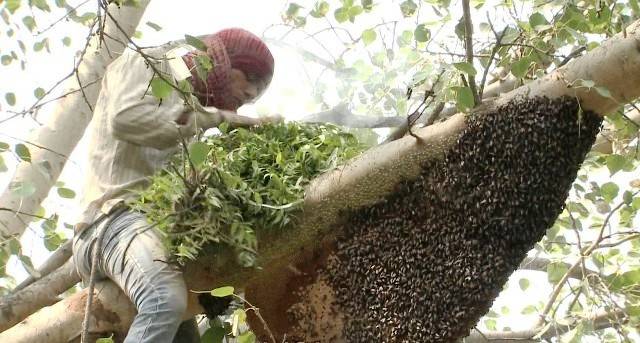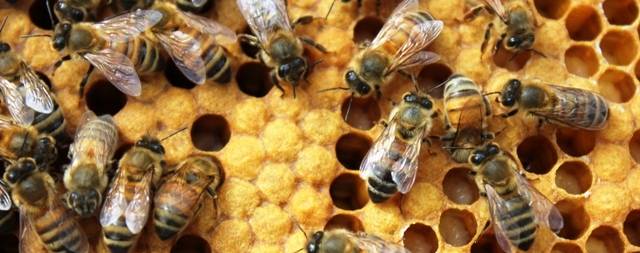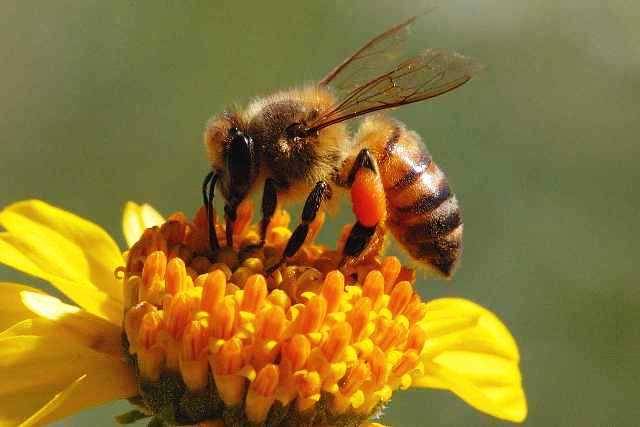
A beekeeper must know the nectar potential of his locality before making any investment to start this enterprise. Nectar is the basic raw product of honey. The days when a good number of plants have nectar to be foraged by honey bees is called a honey flow period. If tile nectar yield is copiously obtained from a good number of plants of a particular species, it is called major honey flow period. When the amount of nectar to be collected is small - it is called a minor flow period and the days when there is no honey flow is called a dearth period. Some examples of suitable localities, based on the availability of bee pasturages in India are described below, as beekeeping is only profitable if bee pasturage is abundantly available in a particular locality.
Click here for: How to judge local nectar potential in your area

1. Kulu valley
Kulu valley in Himachal Pradesh is suitable for bee keeping because there are nectar secreting plants available in large number. It has two major honey flow periods. i.e. spring and autumn. The nectar mostly comes from fruit bloom and barberry during spring. Plectranthus (a flowering plant in Kulu) produces enough nectar during autumn. The dearth period in Kulu valley is not of long duration. It occurs in summer from mid-June to mid-August. Winter dearth period coincides with the coldest part of the year when bees are inactive.
2. Kangra valley
Kangra valley in Himachal Pradesh is suitable for beekeeping because there is a regular flow of bee pasturage, throughout the year. A major honey flow is experienced during spring season whereas an average honey flow is noticed during milder winter. During the rest of the year, a minor honey flow is observed.
3. Punjab plains
The plains of Punjab are not a suitable locality for beekeeping, because it has only a short spell of major honey flows in winter and spring. There is a long dearth period from mid-May to mid-November when bees are active for collecting the forage but bee pasturage is not available in the locality. Also, bees have to face bigger herds of enemies, namely, wasps, ants, wax months, bee-eaters etc.

4. Karnataka state
The western ghat area in Karnataka is famous for its honey and bee wax. Its honey flow period is from mid-January to June. Bee forages (nectar) is available in plenty from plants like Diospyros nontana, D. Candollena, Tenninalia crenulata, Vitex leuconylon and Elaeocarpus setrrantus. A major honey flow i.e. surplus nectar, is obtained from Syzygium cumini, Skeels caryophylatus and Scheffera venulosa. Monsoon season is from June to August. It receives a torrential incessant rains, which confines colonies with sugar syrup. The post monsoon period is from mid August to mid-November, which is a minor honey flow period. Only small amount of pollen and nectar is available from Aneitema, Holigarna, Litsea, Impatiens, Cassia etc. The winter season is from November to January is again a minor honey flow period. Very little forage is available from plants like calamus, caryota. Alseodaphne and Croton. This results in weakening and heavy losses of the colonies.
5. Kashmir valley
Kashmir valley has two distinct periods, i.e. major honey flow, period and winter dearth period. The major honey flow period starting from spring and ending in autumn. The surplus honey yielding sources are: Robinia pseudoacacia, Aesculus hippocastunum, Prunus avium, Rosa spp, Pleetranthus rugasus, Brassica juncea, Fagopyrum esculenlum, Iris eusata, Crocus saliva and lmpatients glandulifera. Kashmir valley is known for its traditional beekeeping which requires nominal expenditure and attention. The only precaution required before adopting the modern beekeeping techniques in Kashmir is against acarine and virus diseases.

6. Uttar Pradesh hills
In this region, bee pasturage is available throughout the year. Both cultivated and wild plants provide pollen and nectar. The colonies develop well in spring. Natural swarming occurs in early March to April. The period from April to June is a major honey flow period. The rainy season is well marked from mid-June to mid-September. The honey bees get less time to collect the pollen and nectar, but bee pasturage is available from a few plants like Tenninalia lomenlosa and several herbs and grasses. Wasp and to some extent wax moth are the worst enemies during rainy season. Autumn season starting in October and ending in November is again good for the development of bee colonies. During this period tendency to rear queens is found in bee colonies. This period have a good honey flow from plants like Eugenia, Prunus, Pletlranlhus etc. During winter from December to January, both availability of bee pasturage and the bee activities decline. Therefore, winter packing is required according to the altitude and severity of winter.
7. Uttar Pradesh plains
In the plains of Uttar Pradesh, summer season from April to June is a honey flow season. The weather is hot, however, bees are active in collecting bees pasturage from cloves. cucurbits., some vegetables and wild trees like Azadirachta. Eugenia, Tamarindus etc. In the latter half of the summer bee flora decreases, brood-rearing depletes to a great extent, water requirements of the colonies shoots up and enemies like wax moth and ants become quite active. Supply of enough freshwater, liquid fluid, shade and windbreak becomes requirements of the colony during summer months.
The rainy season is followed by summer. Besides high temperature, atmospheric humidity also increases. Bee pasturage becomes available in plenty. The plants that provide bee pasturage are : maize. sorghum, cotton and some legumes. The bees collect pollen and nectar during the interval when rain stops. This results in faster bee activities. Under these conditions of high temperature, humidity and less opportunity for bees to collect food, it becomes necessary to make proper check on wax moth and ants. Colonies require open shade and enough thick food.
The rest of the period up to spring through winter is good for bee forage supply. The important plants that provide pollen and nectar are mustard, ram, eucalyptus and cloves. This period receives a good honey flow.
8. Chotanagpur region
Chotanagpur in Bihar is quite rich in flora producing bee pasturage. Except two months of July and August there is a regular supply of bee forages. The important plants of this region are: eucalyptus, mango, litchi, Jamun, karanj, tamarind, Gulmohar, ber, niger, arhar, drumstick etc.
9. Andaman and Nicobar
There are plenty of flora which provide a peak honey collection season from December to May. But this island gets a rainfall of about 300 cm from May to December with cyclones and gales. Therefore, bees are less active during the three months of July to September and require artificial feeding. Rains and wind make the colony weak and sometimes colonies get lost though plenty of bee pasturage is available.
10. Mahableshwar region
This region is rich in bee pasturages. The rainy season in this area is from June to September. During this dearth period, colonies are migrated to plains, where rainfall is about 20 to 24 inches and rich in bee pasturages. The period from January to February is a major dearth period. The main honey flow period is from February to July.

11. Meghalaya region
Bee keeping in Meghalaya has not attained much importance though a number of plants producing bee pasturage are available throughout the year. Some important plants like oilseed crops, vegetables, fruits, plantation crops, and ornamental plants are the natural bee pasturage of this region. The region is best for beekeeping. The weather in this region remains humid throughout the season and the temperature ranges from 5°C to 31°C which is suitable for bee activities. Sometimes winters are very cold. Therefore, migratory beekeeping has been found more popular in this region.
12. Padgaon in Maharashtra
Padgaon region in Maharashtra is one of the major honey yielding centre in southern Maharashtra. A number of plants belonging to families as Araliaceae. Myrtaceae, Combretaceae, Labiateae, Acanthaceae. Rubiaceae, etc. are bee forages. Two honey flow seasons, one major during the summer months and second minor during the winter months are seen. Two dearth periods, one large during rainy season and a shorter during the spring have been spotted for this region.















